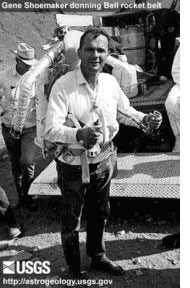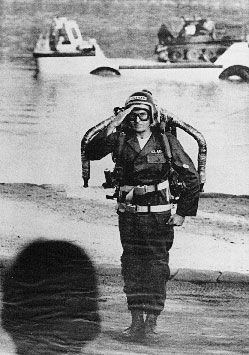Wendell F. Moore worked at "Bell Aerosystems" as an engineer-missileman. He began his work on a rocket pack as early as 1953 (possibly, after learning about Thomas Moore's work). Experiments began in the mid-1950s. Developing the engine did not present difficulties — the application of hydrogen peroxide was well developed by missilemen. The main problem was achieving stable and steady flight; for this, a reliable and convenient control system had to be developed.
In 1959 the U.S. Army contracted Aerojet General to conduct feasibility studies on a Rocket Belt and contracted Bell Aerosystems to develop a Small Rocket Lift Device (SRLD).
The experimental rig, which worked on compressed nitrogen, was prepared. Its steel tubing frame allowed a tester to be attached to the rig. Two hinged nozzles were set on the frame. Nitrogen at 35 atmospheres (3.5 MPa) was supplied to the nozzles by flexible hoses. An engineer-operator on the ground regulated the supply of nitrogen through a valve. Additionally, the tester regulated the thrust using levers under his shoulders. The tester inclined the nozzles forward and backward, trying to reach stable hovering at a limited height. A safety tether was attached from below, so that the rig and tester could not fly too high. The first tests showed that the human body was a very unstable platform. Experimental testing found the best arrangement for the jet nozzles relative to the center of gravity of both the pilot and pack. Experimentation allowed development of directional control for practical flight. Wendell Moore and other members of his group participated in the test flights. These first flights were more like short and sharp leaps, but further experiments proved the concept successful — in 1958 it was shown that the rig could reach stable flight at up to 5 meters for 3 minutes. The success of these experiments persuaded the military to proceed with development. The Bell company was awarded a contract to develop, flight test, and demonstration a practical SRLD.
For the pack they selected a rocket engine with a thrust of 280 pounds-force (1.25 kN or 127 kgf). The pack with its fuel weighed 125 lb (57 kg). The pack had a solid glass-plastic frame contoured to the shape of the human body. The cylinders of fuel and nitrogen were attached to the frame. The Engine was fastened using a hinged assembly that was controlled by levers under the shoulders. The engine thrust was controlled through a regulator assembly connected to a throttle handle on the right lever of the device. The handle on the left lever governed the slant of the (jetavators) nozzles. The pilot was strapped to the frame and the tests of the pack began toward the end of 1960. Test flights were performed in a large hangar "on the leash" (i.e. with a safety tether). Wendell Moore completed the first 20 tethered takeoffs personally, checking the functioning of control systems, revealing deficiencies, and improving the construction of the device.
On 17 February 1961, the safety tether caused an accident. During the flight the pack veered sharply and carried the pilot and device to the left. It reached the limit of the tether, which broke. The pilot and heavy pack fell from approximately 2.5 meter height, breaking Moore's kneecap. He could no longer fly. After this, Moore's associate, engineer Harold Graham, accepted the role of test pilot. On 1 March flight testing was resumed. Graham carried out 36 more tethered tests. These test enabled him to master stable control of the pack. Finally, pilot and pack were ready for the next step. (One of the first flights of the Bell rocket pack. Pilot Harold Graham on 3 May 1961) On 20 April 1961 (the week after Gagarin's flight) on a vacant spot near the Niagara Falls airport the first free flight in history of a rocket pack was performed. Harold Graham reached an altitude of approximately 4 feet (1.2 meters), and then flew smoothly forward at a speed of approximately 10 km/h. Pilot and pack flew 108 feet (less than 35 meters) and then landed. The entire flight lasted 13 seconds. It was at this moment that rocket packs ceased to be fantasy.
In subsequent flights Graham mastered the technology. He learned how to control the pack and perform more complex maneuvers: flying in a circle and turning on a spot. He flew over streams and cars, ten-meter hills, and between trees. From April through May 1961 Graham further perfected his techniques in 28 additional flights. Wendell Moore worked to attain absolute reliability from the pack and confident piloting from Graham in preparation of presenting the rocket pack to the public. In the course of testing maximums of duration and distance were achieved: duration 21 seconds; range 120 m; height 10 m; speed, 55 km/h.
For a timetable of Bell Rocket Belt flights go to http://www.rocketbelt.nl/site.html and click on Bell Rocketbelt and go to the bottom of the page.
 Astrogeologist Gene Shoemaker wearing a Bell rocket belt while training astronauts.
Astrogeologist Gene Shoemaker wearing a Bell rocket belt while training astronauts.
On 8 June 1961, the pack was publicly demonstrated for the first time — before several hundred officers at the Fort Eustis military base. Other public demonstrations then followed, including the famous flight in the Pentagon courtyard. On that day Harold Graham flew before 3000 members of the military department, who observed with enthusiasm.
On 11 October 1961, (according to other data, 12 October) the pack was demonstrated personally to President Kennedy in the course of exponential maneuvers on the military base Fort Bragg. Graham took off from an amphibious LST, flew over a strip of water, and landed in front of the President. Harold Graham, along with an entire command of service personnel, travelled to many cities in the USA. They visited Canada, Mexico, Argentina, Germany, and France, as well as other countries. Each time they achieved enormous success demonstrating the rocket pack in action before the wide public.
But the army was disappointed. The maximum duration of flight of the rocket pack was 21 second with a range of only 120 m. An entire command of service personnel needed to accompany the rocket pack. During flight 5 U.S. gallons (19 liters) of scarce hydrogen peroxide was expended. In the opinion of the military, the "Bell Rocket Belt" was more a spectacular toy than an effective means of transport. The army spent $150,000 on the Bell Aerosystems contract. Bell spent an additional $50,000. The army refused any further expenditure on the SRLD program, and the contract was cancelled.
|

"Rocketman Salutes His Commander in chief". Pilot Harold Graham salutes to the President after successful landing on the coast.
|